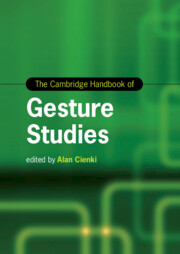Book contents
- The Cambridge Handbook of Gesture Studies
- Cambridge Handbooks in Language and Linguistics
- The Cambridge Handbook of Gesture Studies
- Copyright page
- Contents
- Figures
- Tables
- Contributors
- Introduction
- Part I Gestural Types: Forms and Functions
- Part II Ways of Approaching Gesture Analysis
- Part III Gestures and Language
- Part IV Gestures in Relation to Cognition
- Part V Gestures in Relation to Interaction
- 22 Gesturing for the Addressee
- 23 Gesture and Intersubjectivity
- 24 Variation in Gesture: A Sociocultural Linguistic Perspective
- 25 Communicative Gesturing in Interaction with Robots
- 26 Gestural Interfaces in Human–Computer Interaction
- Index
- References
23 - Gesture and Intersubjectivity
from Part V - Gestures in Relation to Interaction
Published online by Cambridge University Press: 01 May 2024
- The Cambridge Handbook of Gesture Studies
- Cambridge Handbooks in Language and Linguistics
- The Cambridge Handbook of Gesture Studies
- Copyright page
- Contents
- Figures
- Tables
- Contributors
- Introduction
- Part I Gestural Types: Forms and Functions
- Part II Ways of Approaching Gesture Analysis
- Part III Gestures and Language
- Part IV Gestures in Relation to Cognition
- Part V Gestures in Relation to Interaction
- 22 Gesturing for the Addressee
- 23 Gesture and Intersubjectivity
- 24 Variation in Gesture: A Sociocultural Linguistic Perspective
- 25 Communicative Gesturing in Interaction with Robots
- 26 Gestural Interfaces in Human–Computer Interaction
- Index
- References
Summary
Research in conversational hand gesturing shows an array of philosophical senses of intersubjectivity. Gesturing is interpersonally rational, as demonstrated in studies linking gesturing to common ground achievements and effects and to markings of communicative intent. Gesturing is an ecological and interactional activity through which copresent interlocutors codetermine their own social and environmental relatings, building as well as attending to a shared world. Gesturing is an intercorporeal experience central to what it means to live as linguistic bodies. Taken together, research indicates that hand gesturing even as a variegated phenomenon offers insight into how language works. The full story of intersubjectivity and attendant features of recognition, interpretation, normativity, conventionality, and reference begins and ends with actual bodies interacting. As these matters concern the core of pragmatic philosophy, gesture research has radical relevance for all language theorists. An enactive approach to intersubjectivity and language offers a framework for making this case.
Keywords
Information
- Type
- Chapter
- Information
- The Cambridge Handbook of Gesture Studies , pp. 599 - 615Publisher: Cambridge University PressPrint publication year: 2024
References
Accessibility standard: Unknown
Why this information is here
This section outlines the accessibility features of this content - including support for screen readers, full keyboard navigation and high-contrast display options. This may not be relevant for you.Accessibility Information
- 1
- Cited by
